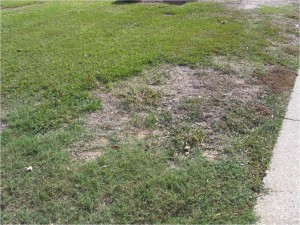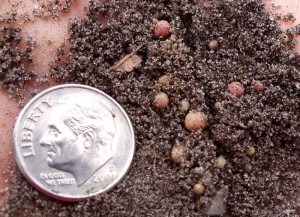What Is Killing My Lawn?
go.ncsu.edu/readext?220151
en Español / em Português
El inglés es el idioma de control de esta página. En la medida en que haya algún conflicto entre la traducción al inglés y la traducción, el inglés prevalece.
Al hacer clic en el enlace de traducción se activa un servicio de traducción gratuito para convertir la página al español. Al igual que con cualquier traducción por Internet, la conversión no es sensible al contexto y puede que no traduzca el texto en su significado original. NC State Extension no garantiza la exactitud del texto traducido. Por favor, tenga en cuenta que algunas aplicaciones y/o servicios pueden no funcionar como se espera cuando se traducen.
Português
Inglês é o idioma de controle desta página. Na medida que haja algum conflito entre o texto original em Inglês e a tradução, o Inglês prevalece.
Ao clicar no link de tradução, um serviço gratuito de tradução será ativado para converter a página para o Português. Como em qualquer tradução pela internet, a conversão não é sensivel ao contexto e pode não ocorrer a tradução para o significado orginal. O serviço de Extensão da Carolina do Norte (NC State Extension) não garante a exatidão do texto traduzido. Por favor, observe que algumas funções ou serviços podem não funcionar como esperado após a tradução.
English
English is the controlling language of this page. To the extent there is any conflict between the English text and the translation, English controls.
Clicking on the translation link activates a free translation service to convert the page to Spanish. As with any Internet translation, the conversion is not context-sensitive and may not translate the text to its original meaning. NC State Extension does not guarantee the accuracy of the translated text. Please note that some applications and/or services may not function as expected when translated.
Collapse ▲
Persistent dead spots that expand outward around 1′ each year are a symptom of ground pearl infestation.
The most lethal pest of lawn grasses in our area is also one of the least well known. Called ground pearl or pearl bugs, these insects can be found damaging lawns throughout coastal North Carolina. In yards infested with ground pearl it is often impossible to maintain a healthy lawn since there are no effective treatments for this pest. Managing lawns infested with ground pearl instead relies on redesigning landscape beds to minimize turf areas, choosing turf grasses that better tolerate ground pearl, and encouraging vigorous turf growth.
IDENTIFYING GROUND PEARL
Lawns infested with ground pearl exhibit dead areas where little grows except a few weeds. These areas may be only a few inches across or up to several feet in size depending on how widespread the ground pearl are, and are often roughly circular in shape. The dead areas expand slowly, by up to a foot each year. If grass is replanted in these spots it usually dies within a year.
Ground pearl infestations can be confirmed by digging in the soil where the insects live. As their name implies, ground pearl are small, round insects that are pearly white to tan in color. They look similar to the pellets of slow release fertilizer found in container grown plants. If you suspect ground pearl in your lawn, dig into the soil 3” to 4” deep around the edges of dead areas and carefully sift through the soil in your hand to find the pearl like insects. Since ground pearl occur in clusters, be sure to check several locations before ruling ground pearl out.
MANAGING INFESTED LAWNS
There are no pesticides that kill ground pearl, which are a type of scale insect. Since only turf grasses are effected by ground pearl one method of dealing with them is to redesign your yard so that trees, shrubs, and flowers are planted in the infested areas. On their own, ground pearl only move a few inches each year. Be very careful not to spread them around when moving soil or using tools or equipment in infested areas. The movement of soil and contaminated equipment is the main way ground pearl are spread over large areas.
While all of the turf grasses grown in our area are susceptible to ground pearl, centipede is the most sensitive. Centipede lawns infested with ground pearl should be redesigned or converted to a more tolerant lawn grass. In a recent trial conducted by NC State University, ‘El Toro’ zoysia tolerated ground pearl damage better than other species in the study. Though often considered a weed, bahiagrass has also been found to be relatively resistant to ground pearl damage. Very vigorous turf grasses like ‘Celebration’ bermuda can be grown in ground pearl infested areas if they receive supplemental irrigation and fertilization. This is more effective in heavy or clay soils. In deep sandy soils it is much more difficult to maintain a dense lawn if ground pearl are present, even when vigorous turf species are planted.
Ground pearl can be found as deep as 10” or more in the soil and can live for 15 years or longer even when no grass is present. Excavating large areas of soil in the hope of removing ground pearl is a very expensive and minimally effective control strategy. Any insects left behind will repopulate new soil relatively quickly since each female is able to produce one hundred or more offspring each year without mating. Excavating soil also increases the risk of spreading these pests to new areas.
OTHER PROBLEMS
Other problems with symptoms that resemble ground pearl include mole crickets and large patch disease. A major difference between ground pearl and these problems is that grass will recover in areas damaged by mole crickets or large patch. Large patch shows up in the spring as rapidly expanding, circular areas of dying turf. The dying areas often appear to have a halo; with the grass on the outer edge appearing yellow or red in color. Hot summer temperatures shut down large disease, allowing infected areas to recover during the summer. Learn more about large patch and see images: //pender.ces.ncsu.edu/2013/05/why-is-my-lawn-dying/
Mole cricket damage is most obvious in late summer and fall. Areas damaged by mole crickets often have an indistinct shape, with living and dead grass mixed together. The ground may be soft and churned up under the dead grass, with dead grass lying on top of the ground, disconnected from its roots. If you suspect mole crickets have caused damage to your lawn, scout injured areas in late June for mole cricket nymphs. At this time, little damage is evident, but young nymphs will begin to show up following a soap flush. Mix 2 tablespoons of liquid detergent in 1 gallon of water. Pour over a 2 to 3 square feet area where damage was present in the spring. Any mole crickets present will surface in a few minutes. This should be done early in the morning or late in the afternoon. Treat if 2 to 4 mole crickets surface within three minutes.
LEARN MORE
For more information about lawn care, ground pearl and other lawn problems, visit the N.C. Cooperative Extension TurfFiles website, http://www.turffiles.ncsu.edu.
Visit your local Cooperative Extension office to learn more about gardening and landscape care. Go to https://www.ces.ncsu.edu/local-county-center/ to find your county Extension center.
- If you live in Pender County, call 910-259-1235
- In New Hanover County, call 910-798-7660
- In Brunswick County, call 910-253-2610
- In Onslow County, call 910-455-5873
- In Duplin County, call 910-296-2143




